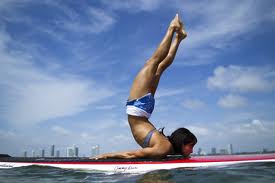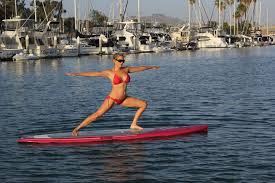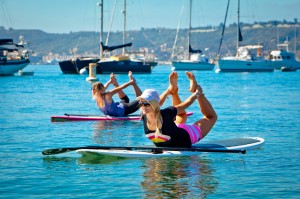It’s no secret that I’m a huge yoga fan, but just like with everything else, the practice can become repetitive after a while. Sure, I could change my yoga style (which I might end up trying before the winter is out), but I’d rather find a way to expand and further challenge myself with the practice I’m doing now. I started to see pictures popping up on my Facebook wall of friends doing yoga on paddle boards (I’ve wanted to try paddle boarding for a while, but I never even considered doing yoga on one).
Some further research was needed. After a few private messages and a bunch of different Google searches later, I think I found exactly what I’ve been searching for. It’s called stand-up paddle board or SUP yoga, and it’s a brilliant concept.
What is SUP Yoga?
Basically, you get a paddle board (which is basically a longer, thicker version of a surf board), head out to the lake or ocean, and do your practice. But it’s so much more than that!
It’s Perfect For Anyone That’s Looking To Get A Better Workout
There’s a ton of balancing involved in yoga anyway, but balancing on a board (that’s only so big) on a body of water makes the balancing act much more important. Your core becomes more engaged and you need to focus more to avoid falling in the water.
The board lets you know exactly how good your posture and balance is as well. For instance, you can easily tell if you put more weight on one side of your body when you’re holding poses such as Downward Dog and you can adjust yourself accordingly.
The Tranquility Value Can’t Be Beat

Seriously, could there be anything more beautiful than floating on the water with the morning breeze blowing through your hair, watching the sunrise over the horizon while you do your sun salutations? I think not. I did yoga on the beach – and believe me, it’s one of the most beautiful things you’ll ever experience (seriously, if you’ve never done it, I strongly suggest trying it once. 5:30 am can be appealing if you do it right) – but something about taking it to the water seems even better.
I mean, think about it – you’re actually floating! This is as close to walking on water as anyone is ever going to get. And I’d imagine that the sensation of floating you experience just has to melt any stress you’re experiencing away. The sound of the water sooths your mind, and in turn you’ll be able to tune into the most important part of your yoga practice – Your breath.
It Can Help You Get Over Your Fears
That’s not to say that no other type of yoga offers that – They all do in their own unique way. But from what I’ve read and heard, the possibility of plunging into the water not only makes you focus more on your poses and breathing, but you get an astounding feeling of accomplishment when you manage to master a move without going for a swim (especially if it’s something you’ve been struggling with). You’ll then take that sense of accomplishment with you throughout your day.
It’s Something Different

Regardless of whether your favorite type of workout is running, HIIT, yoga, Zumba, Bokwa, or something else – Like everything else in life, doing the same thing over and over gets boring after a while. Paddleboard yoga gives you a new perspective on the practice. It could actually reduce the risk of you injuring yourself out of boredom (after doing the same thing so many times, you’re not nearly as careful as you should be about how you’re executing some of those poses. The constant movement of the board in the water keeps you focused. It’s an perfect activity for anyone that’s looking to up their yoga game.
The Adrenaline Rush
That thought of being able to keep your body balanced on the paddle board without falling into the water will give you just enough of an adrenaline rush to keep you motivated and energized and even burn a few extra calories (on top of all the other extra calories you’ll already be burning). All of these things help you fight stress in your everyday life.
You Can Learn From It

There’s a pretty good shot that at least a few times during your first couple of classes, you’re going to fall in the water (I can already tell that I’ll probably be in the water a lot. I don’t have the greatest balance at all – Thank you scoliosis!). The faster you become okay with the idea of falling, the faster you’ll start to notice how much faster you get back up when you fall down in other aspects of your life (because, you know, yoga just wasn’t healing and self-empowering enough already.
There Are Various Difficulty Levels To Work Your Way Through
What I find to be one of the most appealing aspects of SUP yoga is that there’s virtually no end to the physical limits you can (realistically) push yourself to. If you’re starting to find the practice easy, simply switch to a smaller-sized paddle board, and it’s like learning to do the whole process over again!
So now that you know a little bit more about what doing yoga on a stand-up paddle board is all about, you need to know that there are a few things you should consider before signing up for a class in your local area:
SUP Yoga Advice
You Need To Be A Strong Swimmer

From what I gather, most SUP yoga classes start out on the beach, but you’re not going to be there for very long – You’re going to be floating out on the water where the depth is way over your head; waves are inevitably going to be rocking your board while you try and hold some pretty intense poses. This is probably not a class for someone that hasn’t been swimming since they were a kid, nor is it something I’d choose as a first step in a workout plan (because the workout is pretty intense).
That said, if you’re a strong swimmer and you’re even relatively athletic, I think that this type of yoga is definitely worth a shot. Bonus points if you already know how to paddle board (Sidenote: You might want to consider taking an introduction to paddle boarding class before attempting SUP yoga, but it’s not a prerequisite).
Consider What You’re Wearing
When you’re doing yoga in a studio (or even in a park or on the beach), you can get away with wearing just about anything that’s comfortable. But when you’re doing SUP yoga, there’s a lot less room for error (plus like I said before, I’d be incredibly surprised if you don’t fall into the water at least once).
During the warmer summer months, a bikini and/or swimming shorts is a perfectly fine option, and when it’s colder you should opt for some quick-dry yoga clothing that will keep you warm (and not leave you completely freezing to death for the rest of the class if you do happen to take a plunge).
Always Use The Buddy System
I don’t care how good a swimmer you are, I think that SUP yoga should be done and mastered in a structured class setting. I would go as far to suggest that no one should do this on their own, but I know that there are some people who prefer to practice on their own (I’m one of them myself) – If you happen to be one of those people, please take a class first and then please at least take someone with you when you do go out so that if anything does happen (knock on wood of course, but you never know what could happen and safety should always come first – Regardless of what your workout style is, but especially if it happens to involve water), someone is around to see it.
Know What Size Paddle Board To Choose

If you choose a reputable class, the instructor should be able to help you choose exactly what board you need. If you’re just starting out you’re going to want to get the longest, widest board you possibly can because they offer the most stability. As you get better and feel like you need more of a challenge, you choose a smaller board. When paddle boards in general become too easy to work with, start practicing on a surf board. The ladder of difficulty will take you a while to climb, and each rung you conquer will be more rewarding than the last.
Choose Your Instructor Carefully
I’m not saying that all yogis are quacks because that’s, of course, not the case. But I will say that I’ve met some that I wouldn’t necessarily trust during a standard yoga class, much less one that involved us floating on little boards in the middle of the lake – Always research the establishment and instructor carefully; you can never ask too many questions, and you’ll appreciate an establishment or yogi that can answer them all in an educated and effective manner.
I actually asked a few of my friends that have been to a SUP yoga class to let me know what they thought about it, here are a few of the responses I received:
“I’ve only done SUP yoga once, it was also my first time on a SUP board. I was pleasantly surprised how easy it was to balance and hold a pose. Of course when waves approached the board it became a little more difficult to balance. I did fall in the water a few times but it was refreshing. The yoga instructor was very good at explaining every detail as to how to properly and safely use the SUP boards, which I felt was very important to teach us.”
“Love love love! It was so much fun!”
“There’s really nothing more special in the world than the feeling of letting go and being present in nature while practicing on the board. The Downward Dog pose with the view of water, sky and mountain top is absolutely transforming. It’s just one of those things that needs to be experienced to be fully understood.”
It really does seem that just about everyone that tries out this style of yoga loves it almost immediately. And I can’t blame them for a second – Whoever thought of mixing these two activities together is a complete and utter genius. I’m definitely going to give this activity a shot next summer (because November is not the best time to decide to take up any water activity in Canada unless it’s ice skating), and hopefully I’ve convinced you to try it out too.
Have you ever tried an SUP yoga class? What were some of the benefits you personally experienced? We always love hearing personal stories from our readers.
